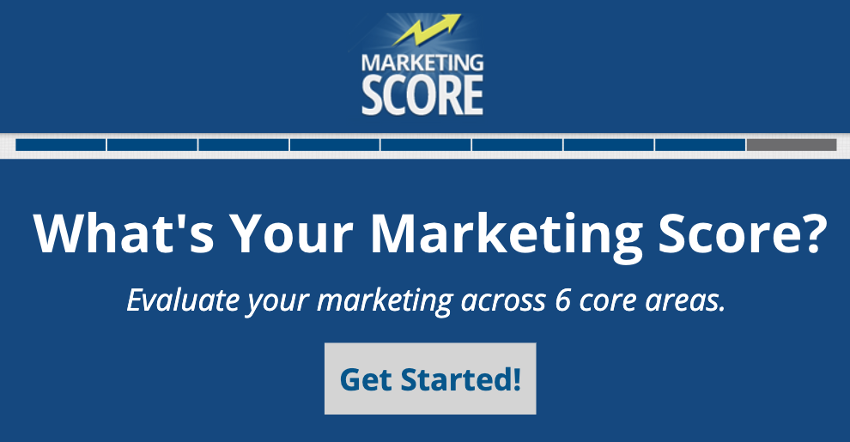According to The 2014 Marketing Score Report, 64% of organizations have aggressive (>20%) or moderately aggressive (15-20%) growth goals.
However, as we learned in analyzing hundreds of marketing assessments, key performance indicator (KPI) weaknesses at every stage of the marketing funnel may be affecting the ability of organizations to achieve their performance goals.

The 2014 Marketing Score Report takes an inside look at how 318 marketers, executives, and entrepreneurs rate their organizations using 132 factors across 10 sections. This chart shows the average factor ratings of nine select factors from the Marketing Performance section.
Download The 2014 Marketing Score Report (no contact information required)
So, as you're building your 2014 marketing strategy, and defining your growth goals and ROI expectations, here are some questions to consider, followed by 15 tips to drive improved performance moving forward.
Marketing Strategy Questions to Consider
- Does your organization have the right marketing talent, technology and strategy to achieve its performance goals?
- Are your expectations for growth aligned with your potential?
- Are there weaknesses in your business and marketing cores?
- Are you maximizing the return on your marketing investments?
- Do you have the right agency partners that fill internal marketing team gaps, and add expertise and skills in critical growth areas?
- Are your resources aligned with priority marketing goals? For example, if “generate leads” is a high-priority goal, do you have the right talent, technology and strategy to achieve it?
- What are the opportunities for underdogs and innovators that don't have the resources of their larger competitors?
- What can large enterprises do to stay on top, when nimble organizations develop more modern marketing teams, more quickly adapt to marketing technology advancements, and build more intelligent and efficient marketing strategies?
Tips to Drive Improved Marketing Performance
- Gain insight from multiple stakeholders. When conducting a marketing assessment, involve key personnel (e.g. executives, marketing and sales leaders) to create a clear, well-rounded view of where your organization stands, and what work needs to be done to increase your potential for success.
- Fill the gaps. During the assessment process, you’re looking for gaps in perception and performance—areas where your organizational goals are unlikely to be met by your current infrastructure, assets, or processes. Identify weaknesses in your talent, technology, and strategy, and concentrate your short-term efforts on improving those areas.
- Commit to core strength. Every organization should be focused on building assets that can be leveraged to accelerate success, including brand awareness, website traffic, social reach and influence, “owned” databases, persona-based content, industry relationships, partnerships, and goodwill. If the core is weak, then you’ll need to invest resources in building the foundation, adapt campaign strategies, adjust goals and timelines, and properly align ROI expectations.
- Figure out the metrics that matter. What are the 5-10 most important marketing metrics for your business? These numbers should be tied directly to business goals, and all marketing activities must be designed around achieving them. For example, for a B2B software company, the top KPIs might be website visitors, content downloads, webinar registrations, sales qualified leads, demo requests, free trial sign-ups, customer wins, churn rate, and recurring revenue.
- Set goal values. Once you know your primary KPIs, assign monthly, quarterly and annual goal values. Also, every marketing campaign should have a primary goal value associated with it. If you can't measure it, don't do it.
- Build a marketing scorecard. Dashboards for measuring marketing effectiveness are simple to build once you know your KPIs and goals values, and are becoming increasingly efficient to maintain. While there are technology solutions that offer robust reporting and visualizations, for many businesses, a straightforward Excel document or Google Drive Spreadsheet will suffice.
- Define and segment audiences and buyer personas. We have entered an era of contextual marketing and personalized customer experiences. In order to capture consumers' hearts, minds, and wallets, you have to target every campaign and communication as much as possible. It starts with well-defined audience segments and personas.
- Break through internal barriers. The obstacles to evolved, performance-driven marketing are many (e.g. legacy systems, conservative cultures and leadership, traditional-minded sales teams), but the modern marketer wins internal battles with data. Use marketing software analytics to turn data into intelligence, and intelligence into action.
- Integrate at all costs. Break down marketing technology and strategy silos in order to maximize efficiencies and ROI.
- Find professionals with "A player" potential. Modern prototype marketers are a rare breed. Develop recruiting and training programs designed to attract and nurture top talent.
- Become a performance-driven marketing organization. Build and evolve your team and technologies to fit your strategy and goals. [Related Resoure: My book, The Marketing Performance Blueprint, provides an in-depth guide for marketers, executives and entrepreneurs to construct their talent, technologies and strategies around performance.]
- Take a full-funnel approach to marketing strategy. If you think of marketing like a funnel, there are four sections—brand, leads, sales, and loyalty. At the top, companies look to build brand, attracting website visitors, blog subscribers, and social followers—basically building their reach. From there, use content, such as blog posts, eBooks and webinars, to move audiences through the funnel and turn qualified visitors into leads. Once lead contact information has been gathered, leverage email marketing and other activities to provide as much value, and as personalized of an experience, as possible. The goal at this stage is to convert qualified leads into sales. Finally, at the bottom of the funnel, conduct campaigns to increase customer loyalty, driving more sales, more referrals, and more profits.
- Balance builders and drivers. Builders are foundational and recurring campaigns, such as blogging and social engagement, designed to create and expand assets. Builder campaign goal values (e.g. visitors, subscribers, social reach) are commonly set by quarter or by year. Drivers are campaigns that capitalize on existing assets to generate short-term returns (e.g. leads, sales), and are often conducted over 1-3 month periods.
- Move your marketing forward. Stop making, and accepting, excuses. Starting driving change.
- Be remarkable. The new marketing imperative is to create more value, for more people, more often, so when it’s time for consumers to choose a product, service or company, they choose yours.
About The 2014 Marketing Score Report
The 2014 Marketing Score Report takes an inside look at how 318 marketers, executives, and entrepreneurs rate their organizations, using 132 factors across 10 sections. The factor ratings (0-10 scale) are combined with 27 profile fields (e.g. annual revenue, revenue goals, marketing budget, employee size, industry, sales cycle length) to provide strategic insights, and help drive change and improved performance.
- Learn how hundreds of marketers, executives, and entrepreneurs rate their marketing programs.
- Drill into charts, data, and analysis from 27 profile fields and 132 assessment factors.
- Compare your Marketing Score report to the benchmark findings.
- Gain insight into critical questions to consider as part of your 2014 marketing strategy.
- Discover how high performers excel in key marketing metrics.

%20Logo_BlueOrange_Trademark.png?width=800&height=269&name=Ready%20North%20(RN)%20Logo_BlueOrange_Trademark.png)




.jpg?width=300&name=Services%20Hub%203%20(3).jpg)



COMMENTS